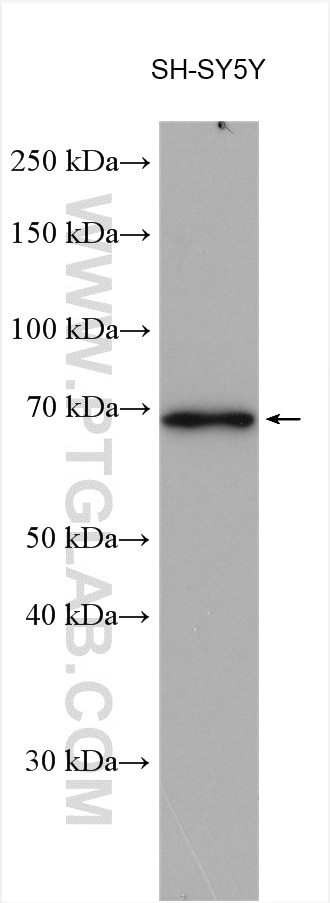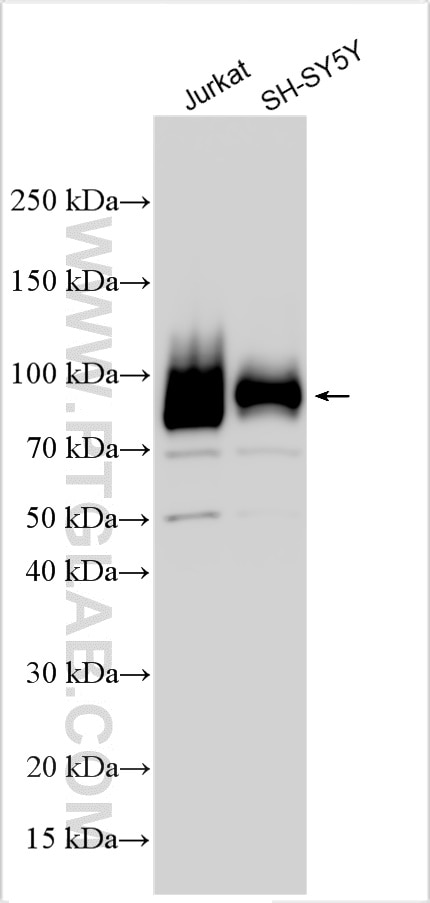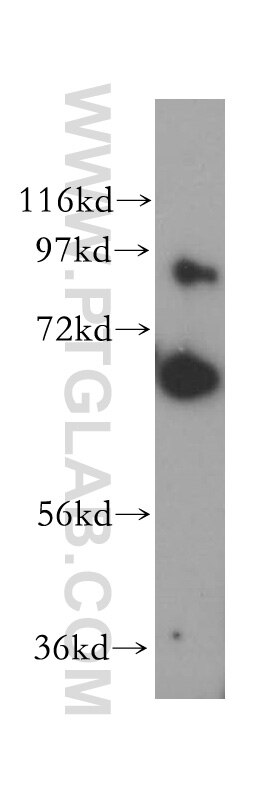- Phare
- Validé par KD/KO
Anticorps Polyclonal de lapin anti-CEP68
CEP68 Polyclonal Antibody for WB, ELISA
Hôte / Isotype
Lapin / IgG
Réactivité testée
Humain
Applications
WB, IF, ELISA
Conjugaison
Non conjugué
N° de cat : 15147-1-AP
Synonymes
Galerie de données de validation
Applications testées
| Résultats positifs en WB | cellules SH-SY5Y, cellules HeLa, cellules Jurkat |
Dilution recommandée
| Application | Dilution |
|---|---|
| Western Blot (WB) | WB : 1:1000-1:4000 |
| It is recommended that this reagent should be titrated in each testing system to obtain optimal results. | |
| Sample-dependent, check data in validation data gallery | |
Applications publiées
| KD/KO | See 4 publications below |
| WB | See 6 publications below |
| IF | See 6 publications below |
Informations sur le produit
15147-1-AP cible CEP68 dans les applications de WB, IF, ELISA et montre une réactivité avec des échantillons Humain
| Réactivité | Humain |
| Réactivité citée | Humain |
| Hôte / Isotype | Lapin / IgG |
| Clonalité | Polyclonal |
| Type | Anticorps |
| Immunogène | CEP68 Protéine recombinante Ag7447 |
| Nom complet | centrosomal protein 68kDa |
| Masse moléculaire calculée | 81 kDa |
| Poids moléculaire observé | 90 kDa, 67 kDa |
| Numéro d’acquisition GenBank | BC002982 |
| Symbole du gène | CEP68 |
| Identification du gène (NCBI) | 23177 |
| Conjugaison | Non conjugué |
| Forme | Liquide |
| Méthode de purification | Purification par affinité contre l'antigène |
| Tampon de stockage | PBS with 0.02% sodium azide and 50% glycerol |
| Conditions de stockage | Stocker à -20°C. Stable pendant un an après l'expédition. L'aliquotage n'est pas nécessaire pour le stockage à -20oC Les 20ul contiennent 0,1% de BSA. |
Informations générales
CEP68, or centrosomal protein 68, is a protein-coding gene in humans. It is involved in the maintenance of centrosome cohesion, likely as part of a linker structure that prevents centrosome splitting. CEP68 is also required for the localization of CDK5RAP2 to the centrosome during interphase and contributes to the formation of CROCC/rootletin filaments. This protein is encoded by the CEP68 gene and is located on the fibers emanating from the proximal ends of centrioles. It has been associated with diseases such as Retinitis Pigmentosa 28 and is implicated in angioedema. The gene is mapped to chromosome 2 and is expressed ubiquitously in various tissues, including the brain, ovary, and others. The protein plays a crucial role in cellular functions related to the centrosome, which is a key organelle in cell division and organization. This antibody recognized two bands of ∼90 and 67 kDa, respectively, in good agreement with the predicted sizes of the two Cep68 isoforms (81 and 67 kDa for Cep68L and -S, respectively).
Protocole
| Product Specific Protocols | |
|---|---|
| WB protocol for CEP68 antibody 15147-1-AP | Download protocol |
| Standard Protocols | |
|---|---|
| Click here to view our Standard Protocols |
Publications
| Species | Application | Title |
|---|---|---|
J Virol The Cytoskeletal Adaptor Obscurin-Like 1 Interacts with the Human Papillomavirus 16 (HPV16) Capsid Protein L2 and Is Required for HPV16 Endocytosis.
| ||
Sci Rep Prolonged overexpression of PLK4 leads to formation of centriole rosette clusters that are connected via canonical centrosome linker proteins | ||
iScience Pathogenic LRRK2 regulates centrosome cohesion via Rab10/RILPL1-mediated CDK5RAP2 displacement. |




